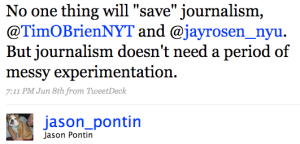Earlier today City University London hosted a roundtable discussion on its campus titled “Practices in Online Journalism”. Throughout the roundtable I was Tweeting updates using the hashtag #pioj. Here are some of the Tweets, followed by more in-depth thoughts on the subjects. You’ll notice that most of these are just statements unattributed to a single speaker. I’m more interested in what was said than who said it, in this instance.
“Gather as wide range of skills as you can so you can show you’re competant across different platforms“.
This subject came up a few different times throughout the session. It’s the idea that students in journalism school today should not be tied to a singular medium. It’s time to face facts that simply being a good reporter won’t cut it in this era of journalism. Fifteen years ago you’d be OK. Probably even as recently as 10 years ago. But not in 2009.
Discussion turned to business models for online journalism. The industry is trying to figure out not only how to be sustainable, but to be profitable, too. But you’ve got to learn to walk before you run, so I suspect the online journalism industry is a good while away from being profitable. I suspect that doesn’t come as much consolation to the 6,169+ who’ve so far lost their jobs in the U.S.
But what if it isn’t the journalism that needs to make money, but the method in which the journalism is distributed? Here’s a note from Matteo Berlucci, CEO of Livestation.
“For entrepreneurism in journalism, the money is in the service, not the content”
He followed this up by explaining why he prefers to use iTunes to get music over the peer-to-peer networks. It’s because he can get the songs quickly, and transfer them to his Mp3 player in a matter of seconds after purchasing. Matteo suggested that this may be a model for news outlets.
We’ve heard about the iTunes model for news and we know it’s mostly rubbish. But that’s not what Matteo is referring to. He’s suggesting that news outlets, whether their newspapers, magazines, or strictly on the Web, need to deliver the news to their readers in their preferred format and to be able to constantly evolve as their readers’ habits evolve.
The rise in popularity of news on the Web has meant that consumers have more options than ever to stay informed in whichever way suits them. This was another subject addressed.
“People can now comparison shop for news.”
It’s unlikely that someone will have just one place they like to go for news, just as it’s unlikely that you’re only going to go to one coffee shop every day. People’s moods change, their beliefs change and their interests change. Personally I visit about 10 different news sites regularly. But each day I’m exposed to new ones. The ones I like, I’ll bookmark and revisit. It’s not possible for a news outlet to be everything to everyone. Brand loyalty in the news is a thing of the past.
And one final note from the roundtable, this time about prospects for student journalists:
“There’s a window of opportunity for people leaving jschool who know how to do multimedia.”
There’s a now-widely read post from Nieman Labs discussing why young journalists need to get beyond their institutional mindsets. Toward the end it notes that many newspaper editors who have young journalists in their newsrooms are finding that these young people aren’t fitting the stereotype that they should be full of angst, ready to change the industry.
I’m going to suggest that the people who are set to change it, the young people, that is, are still in school. In the next 2-3 years, as they begin to filter through their respective programs and into newsrooms, they’ll be the ones who more fully understand social media, who know how to shoot and edit video, and who want to change things.
Filed under: newspaper websites, social media, student journalism, j-school, new media, newsapers, students





Recent Comments